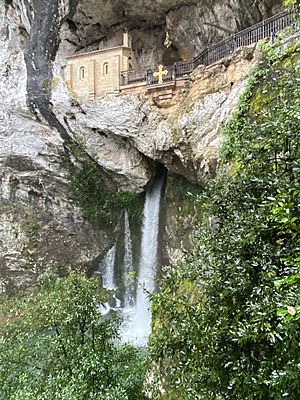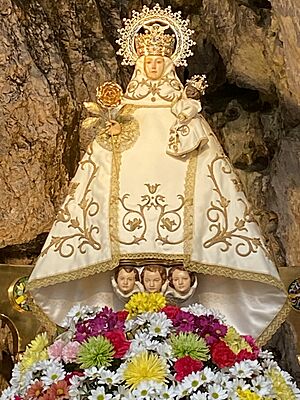Our Lady of Covadonga facts for kids
Our Lady of Covadonga is a special title for the Virgin Mary. She is also lovingly called "La Santina" (which means "The Little Saint"). There's a famous place dedicated to her in Covadonga, Asturias, in northwestern Spain. This holy place became very important after a big battle around 720 AD. This battle, called the Battle of Covadonga, was the first time the Christian people defeated the Moors. The Moors were invaders who had taken over much of Spain. People believed that a statue of the Virgin Mary, hidden in a cave, helped the Christians win this battle in a miraculous way.
Our Lady of Covadonga is a special protector of Asturias. A large church, called a basilica, was built to keep her statue safe. Her special day is September 8th, which is also a holiday in Asturias.
The Story of Covadonga
Covadonga is a mountain area in Asturias, in the far northwest of Spain. In 711 AD, an army called the Arabs (or Moors) invaded Spain. They quickly took over most of the country. The Christian king of Spain, Roderic, was defeated and killed in a battle.
Some Christian nobles, who were important leaders, went into the mountains of northern Spain. They wanted to resist the invaders. In 718 AD, they chose a man named Pelayo to be their leader. Pelayo's father had been an important person in the old king's court. Pelayo gathered a group of fighters to stand against the Arab army.
The Battle of Covadonga
Around 722 AD, the Arab commander sent an army to stop Pelayo's resistance. Pelayo's Christian army decided to make their stand in a place with many caves, known as Covadonga.
According to old stories, Pelayo went into a cave. Inside, a hermit (a person living alone for religious reasons) had hidden a statue of the Virgin Mary. This statue had been saved from the Arab invasion. Pelayo prayed to the Virgin Mary for victory in the upcoming battle.
During the battle, the Christians used the mountains and caves to their advantage. The Arab commander was killed, and his soldiers ran away. This victory was very important. It is seen as the first step in the Christian reconquista (reconquest) of Spain. It also helped create the independent Kingdom of Asturias in northwest Spain.
The Holy Shrine
Pelayo believed that the Virgin Mary had helped him win the battle. Because of this amazing help, King Alfonso I, who ruled later (739-757 AD), ordered a monastery and a chapel to be built at Covadonga. These buildings honored Our Lady of Covadonga.

Over time, the church was looked after by a group of religious people called Augustinian canons. Sadly, a fire destroyed the shrine on October 17, 1777.
The shrine was slowly rebuilt. Eventually, a large and beautiful church, called a Basilica, was finished. It was officially opened in 1901. This Basilica is where the current statue of Our Lady of Covadonga is kept. This statue was made in the 1500s. Pope John Paul II also visited this important shrine when he was Pope.
See also
 In Spanish: Virgen de Covadonga para niños
In Spanish: Virgen de Covadonga para niños


